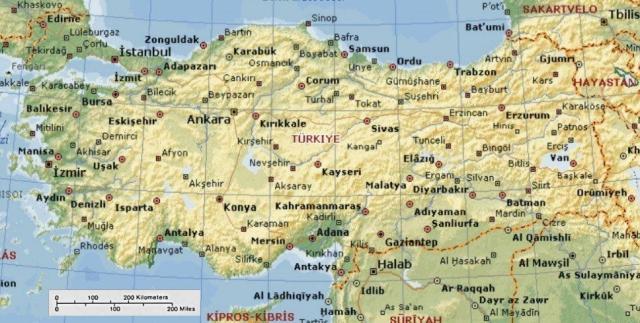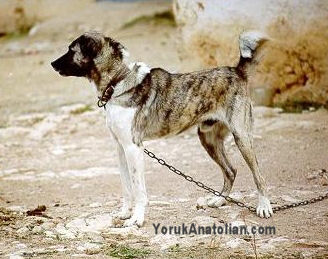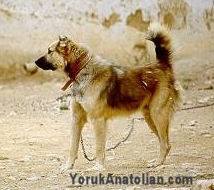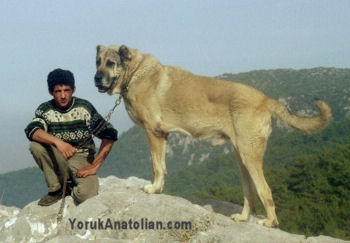![[LOGO]](sm-logo.gif)
![]()
Anatolian Perspectives by
Guvener Isik
Comparative Analysis
of Two Different Strains of Anatolian Shepherd Dogs:
Yoruks and Kangals (first published in Choban Chatter)
ELEVATIONS Izmir 20m * The surrounding mountains
are between 500m and 1300m. |
Sheepdogs in Turkey
All the dogs in Turkey are related to each other; there are not sharp distinctions. Nevertheless, it is impossible not to see the variations or strains. These dogs are ecotype dogs and their general structure is shaped by geographical conditions and by the culture of the people who bred them. What I mean by ecotype is an existing species created by natural selection and adapted to a particular habitat. Since these are not wolves, there is a cultural selection as well.
There are two terms that I am going to use. "Kirik" and "kaba" are to describe coat types. Kirik is a short coat, but it is not like a pit bull short hair. It literally means,"broken", which can be interpreted as "something does not grow enough". Kaba is for long coat, but it does not necessarily mean that all kaba dogs have long coats. It means "wooly" or "a substance that is light yet it has volume". All the kaba dogs have thick, bushy tails, but some kaba dogs have longer hair on their body coat as well. When one touches a kaba puppy and a kirik puppy, he can feel the difference. It feels like the kaba hair's micron size is smaller.
I have some photos which may underline some of the differences. However, I do not have any taxonomic values about these dogs. Most of the time I saw these dogs in the villages and not with the intention of taking photos. I started taking photos regularly since 1997. Even so, it is hard to see the dogs any time one wants to see them, because they are not in the village and one has to find the flock in order to see the dogs. The flocks come down to the villages with the sunset. The yoruk dogs that I have seen when I was 8 to15 years old are not present in the same locations any more. Nevertheless, some of the photos may do.
I did not take the photos in order to compare them later, but to record them in the form of raw data to be interpreted later if necessary.
Patented Dog
The kangal issue is so stressful and confusing now that I'd rather not to talk about kangal, especially when I think about the patent that was received for kangal and the issue of breeding rights of kangal by Sivas province in connection to the patent issue. These are all nonsense commercial moves. How about the dog owners in Kayseri and Konya? They can breed their dogs as usual, but can they call them kangal? One has to get permits in order to breed kangal outside Sivas. The rights of doing research or publishing papers, or representing kangals, all belong to the Sivas Kangal Shepherd Dog club. The kangal standards have changed so many times in the last 20 years. That is why one is forced to look into this issue and that is why it is too tiresome and boring.
It is like only the Greeks can produce Feta. I can produce it, but I cannot call it Feta. If kangal is bred in Ankara and sold to Istanbul and then this dog is exported to the USA, what does it become? There are some French cheeses which have been traditionally made only in a few villages and they have the rights to use the name, but neither is "kangal" a traditional name nor is the breeding limited to Sivas. I guess I have to talk about kangal. There is a saying in Turkish, "One mad man throws a stone into a well, hundred wise men try to take it out".
I do not know whether there is this kind of "right to patent" for the German Shepherd Dog in Germany!
Basic Strains
The first type of dogs in the photos below, Yoruks have relatively square bodies with pointed muzzles.
The second type dogs, Kangals have rectangle bodies with square muzzles and rounder skulls. According to the related city of Sivas kangal web site kangal dog has a square body. According to some others like Kartay, it is longer than taller. Yoruks were known to be larger than kangals, but the remaining population is almost the leftovers of the original populations, because their original keepers are not in the business anymore.
Yoruks are springy in their movements with long strides; they do not pace as frequently as kangals. In general their stomach is tucked up and their chest is deep. Kangals have heavy gaits. Their gaits almost resemble bears. When they are watched from behind, their hips swing to the sides more than Yoruks. The kangal stomach line is close to their chest line. Some of them have apparent barrel-like chest, which they can efficiently use at knocking their opponent. When they accelerate, they can feel the momentum easily. Of course these are how I see them. I am not intending to set rules.
The Challenge of the Terrain
I have seen Yoruk chasing a hare along with two kangals in Denizli. Kangals had very short hair with extremely curly tails and square muzzles. They were really nice specimens and they were being tried by the Denizli shepherd. The yoruks were local to the village. Kangals could not keep up with yoruks when they were chasing the hare up the hill on a rocky surface.
It seemed that yoruks did not feel the rocky surface; they were quite comfortable as they were climbing the hill at full speed, and they made sharp turns with the hare without loosing their speed. Then they disappeared behind a hill. I do not know what happened to the hare, but kangals gave up the chase. This observation cannot be easily generalized and it best not to, but different shepherds have made the same assessment. Of course for the above observation one can say that kangals did better, because they did not leave the flock, which is reasonable. But if there were wolves on the far corner of the flock, yoruks would have been there first. This is an open speculation that one can exercise. My main point here is the speed of Yoruks.
I have seen kangal type dogs in a Kayseri village and watched them when they chased the wolves all night long. There were three dogs and two bitches. They were not as heavy as the standard kangals and the terrain was similar to Denizli and Afyon. I still think that yoruk dogs are swifter in general. These dogs had to move along with the flocks for as long as one month until the flock reached the next pasture, be it in winter or summer. The size of the flocks used to be enormous. I have seen a goat flock that was made up of 5000 goats and I have heard of sheep flocks with as many as 10 thousand. Of course the number of the dogs in protection matters, but distribution of the dogs are not always perfectly random; that is why dogs have to cover hundreds of yards back and forth as the flock moves. When the terrain is hilly, the dogs have to be swifter. I spent a couple of days with shepherds almost every year in western Turkey. Sometimes we cannot see almost half of the flock, because they are either in a valley or on the other side of a hill. Under these circumstances the dogs must not only be swift, but well organized as well. Most of the time an alpha dog will manage the location of the other dogs in respect to the flock. This does not mean that the assigned points are stable; most of the dogs may move a few hundreds yards to another direction and come back to their original locations. This continuous ground covering continues from approximately 6 PM to 6AM in the morning in summer.
This does not mean that kangal dogs are useless shepherds, but their origin is Central Anatolia. It is a high plateau with some mountains. Covering a flock does not require heavy running in flat land. It is easy to see hundreds of yards away. Wolves can see the dogs as well. Wolves will not attack under those circumstances. They would wait for watering time for the sheep. However it is much different in the Taurus Mountain range in the Mediterranean region and in Western Turkey.
If one starts traveling from Eskisehir to Ankara, then to Konya and Kayseri and Sivas, he would be traveling on relatively flat land with some mountains around. However, it is all mountains in the West and in the Taurus region. This does not mean that there are no flat lands in the Western Turkey or in the Mediterranean; the fact is that the ratio of flat land is relatively the reverse.
The Caucasian shepherds that I saw in the Kackar Mountains in the Northeast Turkey were bulky with heavy coats. They were not swift dogs, but were perfect for the steep hills and heavily forested area that receives rain and snow for about ten months a year.
Let's review some of the dogs
| The black dog (right) is the only black one among eight villages I have visited in Bursa. It is about 70 cm [27.3 inches]. His owner told me that his mother was larger than him. He also was about to sell his entire goat flock in 4 months as of November 2004. This dog was very aggressive. I could not get near the flock more than 40 yards. He has not come into the village for two years. He was aggressive to everyone and to the other dogs. His skull type is unrelated to kangal. He is not a good specimen as a yoruk dog, but he is one of the rare black shepherd dogs with a pointed muzzle. | 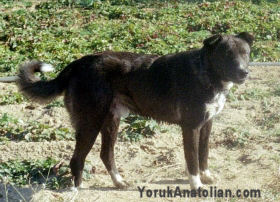 |
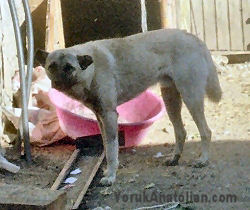 |
This karabas dog is in Bursa. It is resembles the region's old dogs structure wise. |
| The white dog (right) is in Seferihisar, Izmir. The inhabitants of this area are
locals and Yoruks. The people who live in the mountains are all ex-Yoruks. This Akit
(white dog) is a goat shepherd. I spoke with his owner who was a shepherd. He said the
same words that I have been hearing in the last ten years, "Now the flocks are
smaller and wolves are gone and so are the big, handsome dogs". This dog has a pointed muzzle as well. It can be referred as an Akbas, but there were pinto dogs for the same flock as shepherds as well. I know this line since my childhood. When the flocks were larger there were large white, black pinto (not fawn or brindle) and grey dogs with semi-long coats.
|
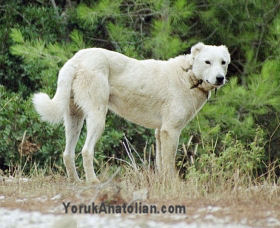 |
 |
The dog (left) which is karabas, is my male dog's father in Cal, Denizli. According to
the owner shepherd, he has about 80% old sheep dog blood. He has some Konya dog blood.
What shepherds mean by old sheep dog is a Yoruk dog. This karabas had an aunt who was more
than 80 cm [31.2 inches] on the shoulder. She had to be shot, because she acted like old
dogs - she was very aggressive with a dog-killing instinct. This dog has really a very different temperament than Konya dogs. Konya dogs are softer and one can pet them. This karabas line is too aggressive towards strangers. There are brindles, dark greys and diluted blacks in his pedigree. They are both short and semi long coated. Their short coats are still pretty thick ones compared to Konya dogs. |
| This dog (right) which has no mask is either his son or his brother. His mask is
almost erased. The shepherds call him old style sheepdog kirik (short coat). Actually in
that very village most dogs were long coated about 15 years ago. The kangal mania influenced everyone and some shepherds crossed their dogs with eastern blood and kept the black masked fawn dogs, although the body form remained pretty much the same. Of course this does not mean that there were not karabas dogs in the western Turkey, but the karabas dog population has increased exponentially recently.
|
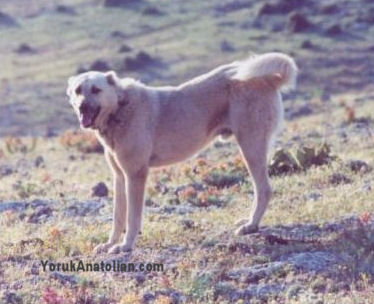 |
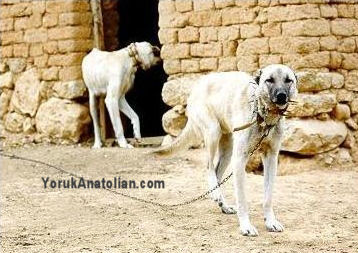 |
These two karabas (left) are either in Denizli or in Afyon. One can see their distinct skulls again. They are wolfish and not heavy. This particular shepherd and the village feed them with donkey before winter. I believe they have no kangal blood in them. |
| This red one is a nine month old and a Yoruk dog too. It is in a mountain village in Afyon. I have seen him in 1997 in November. He has a wolfish skull as well with a domino marking. | 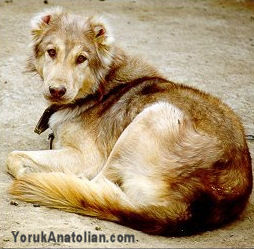 |
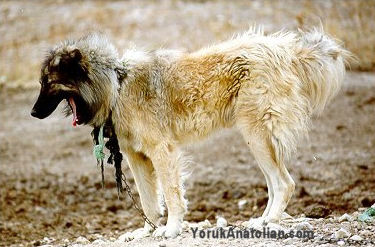 |
This grey long coated dog (left) is in Afyon. He has pretty long hair. His mane hair
was perhaps more than 15 cm [5.9 in.] long. He definitely had very sharp slanted eyes. All
the villagers were ex-nomads. Their dogs used to be as big as newborn donkeys. I believe
this "colt" analogy, because I was in one of those villages when I was about 12
years old. I could not get out of the car when I saw their dogs. Their dogs were so huge compared to the ones I used to see in Diyarbakir (a city in South East Turkey). They did not keep those lines aggressively. However, they saw huge pups born from time to time. They used to feed their dogs with yal [a watery mash], whey and yogurt. |
| The pinto long coated dog is in Sivrihisar, Eskisehir. He had no tail. He was roaming by himself. He was impressive. He was over 80 cms [31.2 in.]. This dog was the whitish one that I have seen in that particular expedition. I covered about 9 villages. I did not take pictures of so many dogs, because I was looking for the white dogs. I have seen so many very pale yellow dogs with almost no mask at all. Half of them were long coated. |  |
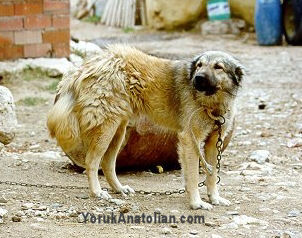 |
This kaba (long coat) dog is in Afyon. He is a sheep dog with a primitive skull. He resembles a Caucasian shepherd. I used to see the same type dogs in Isparta as well. There were some with white coats in the surrounding villages. |
| These two dogs (below) were in the same village. A kirik (short coat) called Sirtlan Alasi (Hyena Pinto) and a kaba. They have square bodies and pointed muzzles. | ||
|
Brindle dogs are called hyena; if they have white spots "ala" is added which means spotted. In the eastern Turkey, they may be called "sarma" which means "rounded" or "covered" with stripes. |
|
Capar is another name used sometimes with a few different meanings. In general they are called "Karayaka" recently in the cities; but it is wrong to me, because it means "black body". Brindles do not have black bodies, they have dark bodies and there are different shades of brindles including red brindles. A real karayaka is a black dog of a lighter boned kangal type and they are believed to be present in Elbistan Mountains. I have seen a black kangal type dog in Bala in 1992. Bala is town located east of Ankara.
| These two dogs (below, both males) are in Sindirgi, Balikesir. The leading one has a perfect square body that I like very much. He is semi kirik. He has a very thick and curly tail that is kept on the left side of the body. The pinto is a kaba one. His muzzle is not as pointed as the karabas, but it is longer than a standard kangal muzzle. The pinto one has thick bones. It is not the hair, which is misleading. The bones are really thick. That could have been a white dog or perhaps he has some white relatives with the same bone structure. That does not fit into Akbas standards, because there are stockier dogs than him in Afyon and they are white. | |
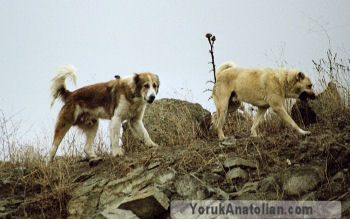 |
Anyway, they got into a fight with three dogs from another flock a few minutes after I
shot this picture. Watching five dogs fighting in a natural setting was exciting. It was
sorted out with minor injuries; they went on their way after the territory issue was
resolved. One of the distinctions of yoruk dogs is their body structure, not the thickness of the bones. The bones can be thick or thin based on the size of the dog. |
| This pale yellow dog with a very wolfish muzzle is definitely a kirik Yoruk. The collar is typical of Yoruk dogs collar. It is made of wool and dyed red and called "ke?e". It is to protect their necks from the spiked collars' friction effect. It is not used in Sivas. If you enlarge the photo and cover the ears part of its head you will see a wolf. Try it you will see. This one was over 75 cm [29 in]. | 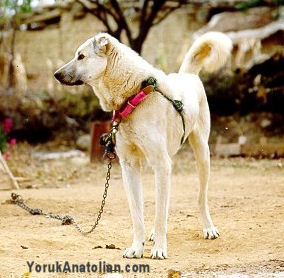 |
This moloss (right) is not from Kangal. It is considered an Aksaray line. Aksaray is not far from Sivas though. He is about 85 cm [33.2 in.] on the shoulder. These dogs are heavy too. They are much slower than Yoruks. The same man has other types of shepherds from different parts of Anatolia such as Maras and Elbistan. One of his dogs was half wolf and extremely sharp. It was about 70 cm [27.3 in.] only. Two of his kizilyaka kangals were pretty wary of him. |
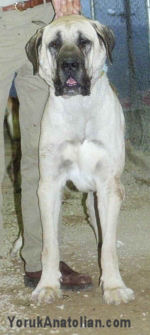 |
 |
This dog (left) is a Kangal. He has typical kangal ears and round skull and semi square muzzle. |
| This dog (right) is in Denizli. He has Haymana and Yoruk in his lines. He is 86 cm [33.5 in.] on the shoulder. I measured his paw size as 11 cm*11 cm. [4 in. x 4 in.] His head type is very moloss. His skull is round like a kangal skull. He is about two years old. He never wrestled. He stayed with a sheep flock, but he is not a guard. His father is 80 cm [31.2 in] on the shoulder and he is very famous. His name is Topal (lame), because he limps. This line is very famous in Denizli region. I own his half sister. This dog can also be petted. The shepherd Ibrahim's sheep dogs have longer coats and are sharper and smaller than he. | 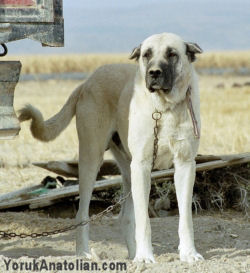 |
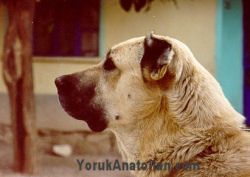 |
This dog (left) is Hasan. He was famous in from 1996 to 2000. He is a very calm wrestler. He is a Haymana line and he is the grandfather of the previous dog. His temperament is friendly with people. He is 82 cm [32 in.] on the shoulder. He is owned by Necati Acar who was a friend of my grandfather. He also is not a shepherd, but some of his lines attend the flocks. One of my bitch's sisters is an active shepherd as is her mother. |
| This kangal (right) is in Sapanca. It has a typical kangal muzzle. | 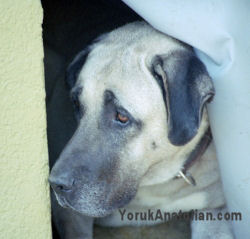 |
 |
This kangal (left) is in Balikesir works as a dairy guard. His front lips are also hanging. |
| For further comparison [of Yoruk and Kangal types], contrast these two fawn karabas dogs. The first photo (left, below) is labeled Civril Kirik Yoruk YY. He had a brother. I did not measure them, but I believe both of them were about 90 cm [35 in] tall on the shoulder. It is obviously very leggy. This dog was in a mountain village and is definitely not a kangal. The other one (right, below) is labeled Perfect Kangal Head KK. It was brought from south of Sivas to Izmir by Aral Altay. It is not a bony dog and it is almost square, but it is not well fed. |
||
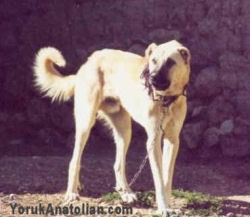 |
In order to see the difference one must look at the structure, not the colour. | 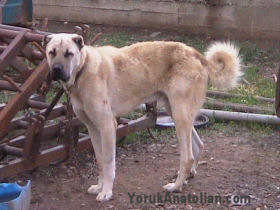 |
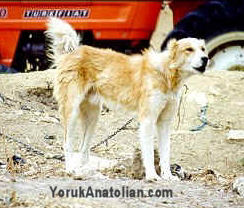 |
These two photos (left and right) are kaba Yoruk dogs from Denizli and Afyon. The domino masked one was so super fast that it was a pleasure to watch him in the flock. |
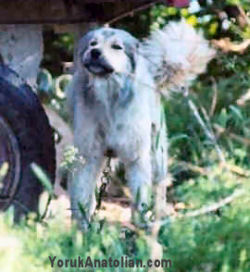 |
Dogs from Aksaray, Erzincan, Konya and Kangal are all considered kangals, because it is easier to sell them under the kangal name.
Konya dogs are the most successful wrestlers. Perhaps wrestling ability was appreciated as well as fighting against the enemy in the ancient Hittite empire. These dogs can attack man as well if they are raised in a certain way and they can be devastating. That is why I consider them as the old war dogs, but not primarily shepherds.
Konya, Karaman and Aksaray were the main Hittite settlement areas and they kept this kind of dog based on the pictures on the stones found in the area.
There are shades of morphologies. The way I see it, is wolf on one end of the scale and a moloss on the other end. Perhaps jackal interjects now and then. Yoruks are more wolfish with lots of moloss blood, and kangal and haymana are more moloss with less wolf blood. Wolf crossing is a separate issue that I may talk about later.
All these dogs belong to a big family with several strains or varieties. One can see a moloss head, kaba coat dog among the other typical yoruks. These show the effects historical migration and breeding practices. That is why, although I try not to miss the bodily structure, I consider the temperamental structure as well. I try to place these qualities according to the geographical regions, because genetic acclimatization is unavoidable. Some sort of segregation takes place under minimally supervised conditions.
Another reason for the kangalization process is the common, uniform colour: fawn body with a black mask.
Yoruk dogs can have the same colour, just like English thoroughbreds can bear the same colour as Arabians. However it is easy to classify based on the colour. It must be because of the culture of globalization. There are white and black people in the USA. Some Indians are darker than Africans and they are different races and Europeans are composed of several races. but they bear paler skin. People make the same mistake when they classify animals and plants.
There are yoruk type dogs all over Turkey. Kangal type is concentrated in Sivas and Konya regions. Yoruk means nomadic Turkmen; Turkmen ruled at every corner of Anatolia, but their heaviest settlements are in the Western and Southern Turkey. Yoruk type dogs can be seen in South East Turkey among Kurdish tribes. There are still a few nomadic Yoruk and Kurdish tribes in Turkey. Their lifestyles are similar and dictate the type of the animals they can keep.
There are undiscovered areas in Mediterranean and South East Turkey in relation to shepherd dogs. The conflict between Kurdish guerillas and Turkish military caused so many flocks to be sold and slaughtered. Some villages cannot take their flocks to the highlands in the summer time, so they sell the flocks. Once they are sold they are not replaced again and the villagers move to the cities. The same is true in Sivas, although there was not a tangible terrorist activity in the past. In general whether there is terrorism or not, the flocks are getting smaller because of the global pressures on the Turkish economy and politics. It is not hard to forecast the total extinction of goat flocks first and sheep later in the next 15 years.
According to a deceased army vet General Oncul, the largest dogs were nomad dogs. He did not consider Sivas dogs as the largest and fiercest. He also talked about Karayaka dogs as a separate breed, but he did not research them very much. He termed Sivas dogs as Karabas and he stated that the best karabas dogs could be found in Sivas. When I visited his breeding and training program with my father in probably 1980, there were close to 100 karabash dogs, a few kaba white dogs and a huge kaba Yoruk karabas. That dog looked like a lion to me, size wise.
He talked about nomad dogs very briefly and no one brought them up again since 1983. I remembered what I heard, from his breeding program in Gemlik, Bursa, when I was traveling to understand more about the shepherd dogs in 1997. Then I realized their existence. If there are Yoruks and they are nomads, then their dogs must be called Yoruk dogs; not Turkish, Anatolian or nomad.
I heard about yoruk dogs from my father when I was a child, but he termed them as "koyuncu" and he told me Yoruks keep them. "Koyuncu" means "sheep-man" not sheep herder. It means a dog that works with sheep. His term will lead to something else. So I should stop here.
From the Author:
I have owned shepherd dogs since I was 8 years old. My grandparents had them for guarding their properties and animals. I grew up hearing stories about them from my father and my grandmother. My grandmother still talks about her dogs. I have always been attracted to their primitive looks but more importantly to see them in action as working dogs.
Writing something about these dogs occurred to me in 1993, but I really didn't have the knowledge required to fill a book. I had to wait until 1997 with a clear intention to collect data about them. When I research them I research a life style. These dogs are one of the windows that one can see and analyze the circumstances of the rural people and nature. I had to learn about sheep, goats, donkeys, horses, cattle, bees, cats, wheat, carpets, forests and wolves along with history and genetics in order to have a multifaceted perspective about these dogs or about everything surrounds them. The main motivator behind studying these dogs is my uneasiness about the disappearing rural life styles in Turkey. I know that we need native sheep and goat flocks and wolves in order to preserve these dogs. Without these we can only preserve dogs with diminishing quality at every generation. We cannot choose and preserve them without the combined interaction of the flocks, shepherd and the wolf with these dogs. It feels like we are trying to keep water from running through our fingers. It will disappear in the end
------ Visit Guvener Isik's website at http://yorukanatolian.com/
Other reading on Anatolian Shepherd Dog Breed History
- Comparative Analysis of Two Different Strains of Anatolian Shepherd Dogs: Yoruks and Kangals - by Guvener Isik
- Stray, Street and/or Pariah Dogs - by Guvener Isik
- The Greyhound Of Anatolia: Turkmen Tazi - by Guvener Isik
- Bozkir Canavari: The Steppe Monster - by Guvener Isik
- Interview with Dogan Kartay - by Guvener Isik
- Malak and Furthermore Greyhound Turca - by Guvener Isik
- Excerpt on Breed History - "The Heritage of the Dog" (Book Review) - by Jennifer Floyd
- Letter from Sue Goldhor - Real Working Dogs - Anatolian History - by Dr Susan Goldhor
- Collecting Dogs - by Dr Susan Goldhor
- Finding Capar - by Susan Goldhor
- Gentrification of Working Breeds - Good or Bad? - by John Burchard Ph.D
- The Sheep of Turkey - Relationship between Turkish sheep colors and Anatolian colors. - by Catherine de la Cruz
- Mektup of Obruk - Putting the Record Straight - by Caroline Southen
- UKC Article - about the Anatolian - by Mary McDaniel
- Yal: The Traditional Dog Food In Anatolia - by Guvener Isik
- Dog Days - A gift from a Turkish Ambassador - by Dee Brown
- The Kuvasz Akbas Relationship - by Guvener Isik
- Sirtlan - Traditional Values - by Guvener Isik
- Morkaraman Dogs of Agri -by Guvener Isik

This page copyright by Anatolian Shepherd Dogs International, Inc. ? .

